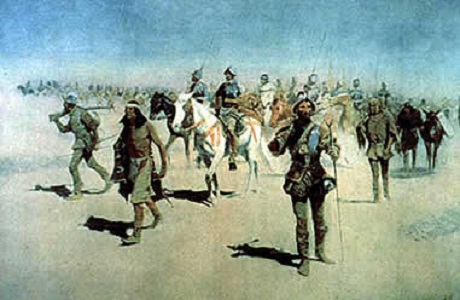
Courtesy of the Texas Council for the Humanities through Wikimedia Commons
Born in Salamanca, Spain in 1510, Francisco Vazquez de Coronado lived there for 25 years before his journey to the Americas. While in Mexico, Coronado became a prominent figure in Mexico City’s council after developing a close friendship with the first viceroy of New Spain, Antonio de Mendoza. Coronado acquired an enormous estate from his marriage to the daughter of a colonial treasurer and was governor of New Galicia by 1538. Despite his great fortune and status in Mexico, Coronado wanted to follow in the footsteps of other Spanish explorers who attempted to discover the “Seven Cities of Cibola or Gold.” When Mendoza commissioned Coronado to command the expedition to Cibola, he accepted the mission, and on February 23, 1540, Coronado and his crew sailed out from Mexico’s west coast en route to the golden cities.
Although explorers since the early 1500s failed to find the seven mythical cities, Coronado and Mendoza were convinced they existed upon receiving confirmation from Fray Marcos, a priest who returned from an earlier expedition with reports of the “Seven Cities of Cibola.” Since the purpose of the expedition was as missionary and not for conquest, Fray Marcos joined Coronado’s crew, and on July 7, 1540, they reached the first of the seven legendary cities. To his disappointment, Coronado found that the settlement of Hawikuh was not a city made of gold but instead a rocky pueblo inhabited by American Indians. Disregarding Mendoza’s original orders, the Spanish conquered the native village by attacking and forcing the residents out of the pueblo. At the same time Coronado removed the Indians from Hawikuh, the crew sent Fray Marcos back to his home in Mexico.
After establishing their headquarters in the native town, Coronado sent a number of his captains to explore the surrounding territory in what is today Arizona, Colorado, and the Grand Canyon. While Coronado waited in Hawikuh, Captain Hernando de Alvarado reached the Plains Indian tribes on the Pecos River and met an American Indian he named The Turk. The native informed the Spaniard of the existence of the golden city they sought, and on April 23, 1541, Coronado’s army followed The Turk to the mythical city he called Quivira but faced disillusionment when they found a small village made of grass and not of gold. Coronado and his men killed The Turk, when they learned his story was a plot to lure the Spaniards out of Pecos and into the Plains where they would starve to death.
Realizing his mission was a failure, Coronado and his crew -- except the priests who chose to stay and convert the American Indians to Christianity -- returned to Mexico City in 1542. To Mendoza’s disappointment, Coronado did not return with gold, but he did bring back great knowledge of the land and the American Indians they encountered. This information would prove useful to future explorers. Despite his failure, the Spanish viceroy cleared Coronado’s name and allowed him to resume his position as governor of New Galicia, where he would die ten years later at the age of 42. Although Francisco Vazquez de Coronado died in obscurity after his expedition failed to discover the seven golden cities, his voyage is significant today for the cultural influence the Spanish had on the territory and peoples of America’s Southwest.
At Coronado National Memorial, visitors can enjoy the panoramic views of Coronado’s probable route along the San Pedro Valley and other activities such as auto touring, caving, hiking, and birding. The Memorial’s visitor center has a picnic area, and visitors can obtain a map that will guide them to the Nature Trail, Cave Trail, and Montezuma Pass. The Memorial overlooks the border between the United States and Mexico and has two sister parks, Chiricahua National Monument and El Chico National Park, both located in Mexico. These sister parks are reminders of the resources and history the United States and Mexico share and the lasting ties. Nine pre-contact sites belonging to the Cochise Culture surround Coronado National Memorial. The sites have brought information and insights about each of the transitional phases -- Sulphur Springs, Chiricahua, and San Pedro -- the Cochise Culture witnessed from 9000 B.C to 2100 B.C.
Coronado National Memorial, a unit of the National Park System, is located at 4101 E. Montezuma Canyon Rd. in Hereford, AZ. Click here for the National Register of Historic Places file: text and photos. The Memorial is open all year from dawn until dusk. The visitor center is open daily, excluding Thanksgiving Day and Christmas, from 8:00am to 4:00pm. Admission is free. For more information, visit the National Park Service Coronado National Memorial website or call 520-366-5515.
Coronado National Monument is also featured in the National Park Service American Southwest Travel Itinerary.
Last updated: August 11, 2017
